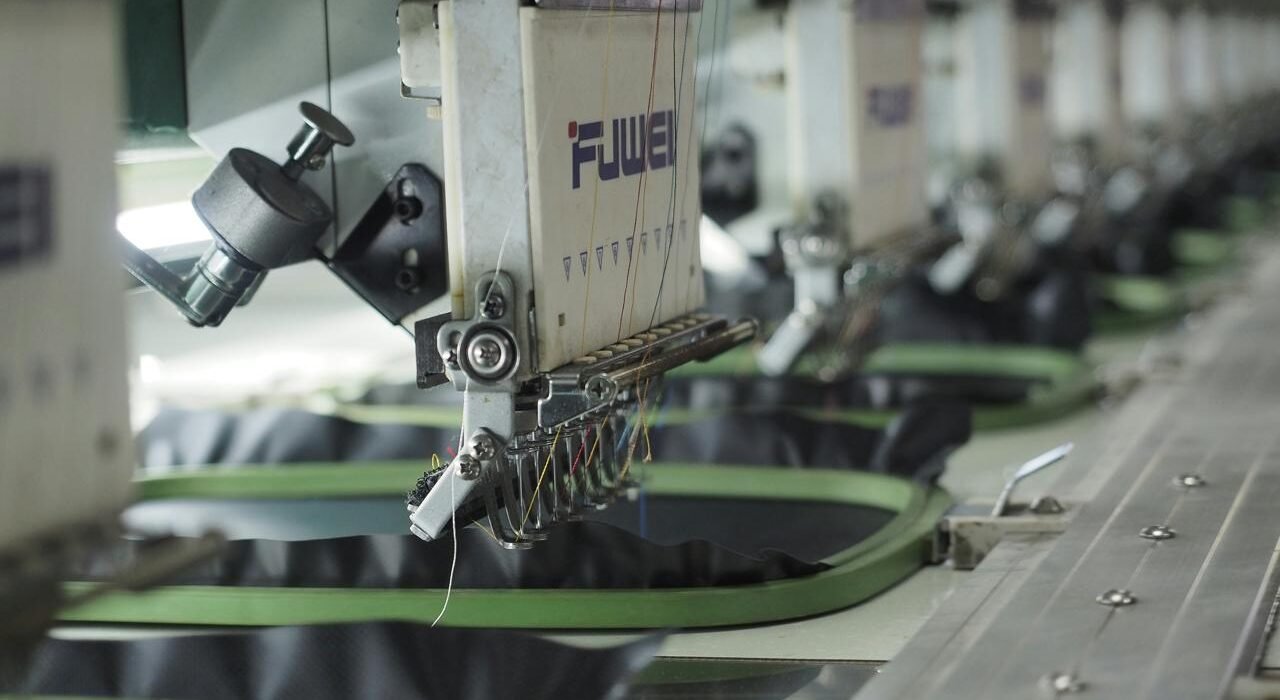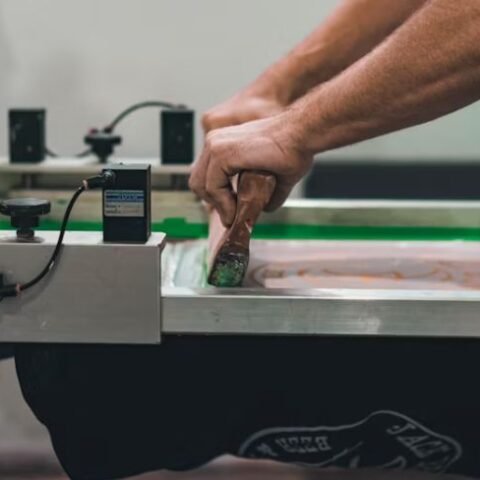Embroidery vs. Screen Print: The Deathmatch
When it comes to custom merch, two giants have ruled the arena for decades — embroidery and screen printing. They’ve both dressed armies of brand ambassadors, filled school closets, and fueled merch drops for every possible niche. But which one really reigns supreme?
In this no-holds-barred deathmatch, we’re pitting these two against each other — stitch by stitch, print by print — across durability, cost, turnaround time, aesthetics, and brand perception. By the end, you’ll know exactly which method deserves the championship belt for your next project.
Round 1: The First Impression — Texture vs. Print
Walk into any room wearing a shirt with a crisp embroidered logo, and people notice. The raised threadwork, the three-dimensional texture, and that subtle shine under light scream premium. Embroidery gives off a tactile, high-end vibe — perfect for polos, uniforms, and jackets.
Screen printing, on the other hand, wins the visual punch. It’s bold, bright, and infinitely customizable. The ink sits flat on the surface, allowing for intricate designs, gradients, and vivid colors that embroidery simply can’t reproduce. Think band tees, event merch, or startup drops — screen print is your visual billboard.
Verdict:
If you want your design to pop visually — go screen print.
If you want it to feel luxurious — go embroidery.
Round 1 ends in a tie.
Round 2: Durability — Who Lasts the Longest?
Embroidery is practically immortal. Each stitch is a thread woven directly into the fabric, meaning it can survive hundreds of washes, sunlight, and daily wear. That’s why uniforms, caps, and workwear often rely on embroidery — it doesn’t fade, peel, or crack.
Screen printing’s durability depends heavily on technique and materials. A well-executed print using plastisol or water-based inks can last years, but neglect proper curing and your masterpiece starts to flake. Heat-set inks and quality pre-treatment can bridge the gap — but embroidery still takes the gold for endurance.
Verdict:
Embroidery wins this round. It’s the heavyweight champion of longevity.
Round 3: Cost — Who’s the Budget Killer?
Here’s where screen printing shines like a freshly pulled squeegee. Once the screens are made, every print becomes cheaper. Bulk orders slash the cost per shirt dramatically, making it the go-to for schools, startups, and event merch. The setup cost might bite a little upfront, but at scale, it’s unbeatable.
Embroidery costs scale differently. Each stitch counts — literally. Complex logos with thousands of stitches or color changes push machine time higher. Embroidery threads are pricier, and setup involves digitizing artwork into stitch files. But for small runs or premium uniforms, that higher cost translates to perceived value.
Verdict:
Screen printing wins for large batches.
Embroidery holds its ground for small, premium jobs.
Call it 2–1 for screen print.
Round 4: Fabric Compatibility — The Substrate Struggle
Not every fabric plays nicely with ink or thread.
Screen printing works best on cotton, blends, and smooth polyester. Rough or water-repellent materials can cause ink to sit awkwardly or break up over time. Embroidery, however, doesn’t care — it’s the brute force method of decoration. Thick hoodies? No problem. Structured caps? Easy. Leather patches or denim jackets? Bring it on.
However, embroidery does have a weakness — thin, stretchy fabrics. The tension from stitching can warp or pucker the surface, which means your sleek athletic tee might not look as sleek afterward.
Verdict:
Screen printing wins for light garments.
Embroidery dominates on structured and heavy fabrics.
Score’s tied again.
Round 5: Turnaround Time — The Speed Race
Let’s be honest: speed matters. Whether you’re racing to deliver merch for an event or restocking your shop, turnaround time can make or break the project.
Screen printing is fast once set up. Load, align, pull — repeat. Modern automatic presses can crank out hundreds of shirts per hour with consistent quality. Embroidery? It’s more of a marathon. Each piece runs individually through the machine, and the setup for multiple color threads takes time. Small orders are fine, but bulk embroidery can be painfully slow.
Verdict:
Screen print wins the sprint by a mile.
Round 6: Brand Perception — The Story You Tell
Every decoration method sends a message about your brand.
- Embroidery whispers class. It’s what luxury brands, corporate uniforms, and boutique apparel lines rely on. When your logo is stitched, it says you’re not cutting corners.
- Screen printing, however, shouts creativity and culture. It’s the streetwear of merch — bold, expressive, and alive with personality.
The choice depends on your tribe. A hospitality brand or corporate office? Embroidery. A music label or creative agency? Screen print.
Verdict:
Split decision — depends on your brand DNA.
Round 7: Environmental Impact — The Green Factor
With sustainability becoming a brand value, production methods are under the microscope. Traditional screen printing relies on plastisol inks, which contain PVC — not exactly eco-friendly. But water-based inks and newer discharge methods are changing that game.
Embroidery, meanwhile, produces minimal waste but uses polyester threads, which aren’t biodegradable. That said, recycled and organic threads are now available, and both industries are moving toward greener workflows.
Verdict:
Slight edge to screen print with water-based inks — but both are catching up fast.
Round 8: Maintenance and Aftercare
Ever had your favorite printed tee start cracking after months of abuse? That’s the pain of cheap screen printing. Properly cured inks fix most of that, but still — embroidery wins the long game. The only risk? Thread fray over extreme abrasion.
Maintenance also depends on wearer habits. Turn shirts inside out before washing, avoid harsh detergents, and skip the iron directly on the design. Do that, and both methods will age gracefully.
Verdict:
Embroidery’s resilience takes this one.
Round 9: Versatility — The Final Flex
When it comes to creative range, screen printing is the artist’s dream. You can print across seams, sleeves, or even entire panels. Add specialty inks — metallic, puff, glow-in-the-dark — and the possibilities explode.
Embroidery, while limited in size and detail, makes up for it with tactile impact. Adding 3D puff embroidery, metallic threads, or appliqué patches can elevate your product into retail-grade territory.
Verdict:
Screen print wins for creative range.
Embroidery wins for tactile luxury.
It’s a stylistic deadlock.
The Final Bell: Who Wins the Deathmatch?
If you’ve read this far, you know there isn’t a universal winner — there’s only the right match for the right job.
| Category | Winner |
| Aesthetics | Tie |
| Durability | Embroidery |
| Cost Efficiency | Screen Printing |
| Fabric Range | Tie |
| Speed | Screen Printing |
| Brand Perception | Depends on Audience |
| Sustainability | Screen Printing (water-based) |
| Aftercare | Embroidery |
| Creative Range | Tie |
Final Score: 5–5 Draw.
No knockout — just respect between two heavyweights.
So What Should You Choose?
Here’s the cheat code:
- Corporate apparel, uniforms, and premium merch? Go embroidery. It elevates your brand presence and survives years of wear.
- Event merch, creative campaigns, and large runs? Go screen print. It’s fast, bold, and cost-effective.
- Want both? Hybrid it. Screen print your large graphics and embroider your logo. The mix of texture and print is next-level branding.
At the end of the day, both embroidery and screen printing are tools for storytelling. One sews it in; the other prints it loud. And when done right, either one can make your brand unforgettable.




